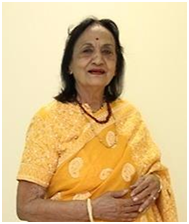By Dr. Usha Saraiya
There are 3 Women who lived in and around Mumbai who have been honoured by having a “Crater” on Venus named after them. It is a tremendous tribute to their contribution to Humanity on Planet Earth.
The 3 great ladies are Dr. Anandibai Joshi (1865-1887), Pandita Ramabai Dongre Medhavi (1858-1922) and Dr. Jerusha Jhirad (1891-1984).
This article will review the biographies of all of them. They lived and worked in the 19th and 20th centuries. Needless to say they all have made outstanding contribution to medical relief and also to the improvement in the Socio-Cultural conditions of that era and therefore deserve to be immortalised on Planet Venus.
When you look at the Moon and Mercury, their surfaces are pounded with impact craters. Mars has many craters and so does Earth. Venus has about 1000 craters identified on its surface.
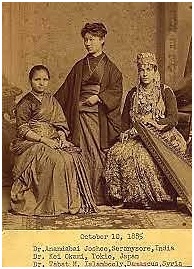

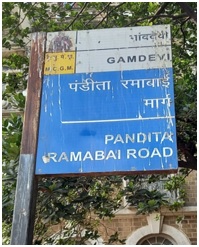
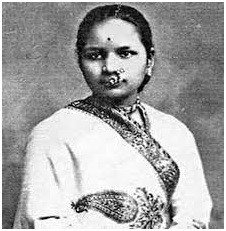
Venus is supposed to be the planet for women and Mars is supposed to be planet from men. Venus is a Goddess of love, beauty and fertility in Greek mythology.
In 1991, Scientists studying Venus with Magellan spacecraft (Photo 1) proposed that these craters be named after famous women, instead of giving them numbers. It was agreed to give Eponyms. Oxford English Dictionary defines Eponym as “A person after whom a discovery, invention, space, etc. is named or thought to be named”. In Medicine there are over 15,000 Eponyms. The International Astronomical Union approved this proposal. Since then many craters have been named.
The famous women after whom craters are named include playwright Lillian Hellman and Diplomat Clare Booth Luce, Margaret Mead, the anthropologist and Pearl Buck the famous author also feature in the list.
From India we have only these 3 ladies who have received this honor.
Let us look at the brief biodatas of these 3 ladies
1) Dr. Anandibai Joshee (1865-1887)(Photo 2)
Crater named after her is JOSHEE CRATER. Dr. Anandibai lived in Kalyan which was then a suburb of Mumbai. Her Maiden name was Yamuna. She was married at the age of 9 years to Gopalrao Joshee who was a widower and 17 years older than her and he was obsessed about educating women. After marriage she lived in Mumbai and in Alibaug. At the age of 13, she had a child but lost it very soon due to lack of Medical care.
He started educating Anandibai by enrolling her in a Missionary school in Bombay. Others from their community made fun of her and were very unkind but she was strong minded and continued. She soon became fluent in English and could give lectures.
In mid 19thcentury there was a Reformist movement in India and particularly in Maharashtra. Liberal thinking persons like Ranade, Agarkar and Bhandarkar spoke in favour of Women’s Education and widow remarriage. Gopalrao was influenced by their views. Views of women were not considered and they were forced to study. Their usual work load of house hold duties continued. Along with these views old views of total subordination of a wife also continued. It was difficult but challenging time for women but they managed to cope.
In 1878, news of women becoming Medical Doctors trickled in from England and America. There was much opposition in those countries also for women to join Medical Colleges. But they did succeed and were honoured for their fortitude. That inspired Gopalrao to think of making Anandibai a Medical Doctor. She accepted the idea, as she had lost a precious new born due to lack of healthcare and was happy to be able to join that noble profession. The only way was to ask the Missionaries for help and he started doing that. There were many issues involved which were not acceptable to the Joshees A chance encounter with Carpenter family changed the scenario completely.
Finally Anandibai sailed to New York on 7/4/1883 and was received by Carpenter family with love and affection. She entered the Women’s Medical College of Pennsylvania, in which many International students were enrolled.(Photo 3)
She was a good student and made friends with all the local and International students. She graduated in 1886 after a 4 year course and was awarded MD. Thus she became the 1st Indian Woman Doctor to fully qualify.
She had a triumphant return home and was congratulated by none other than Queen Victoria. She and Gopalrao were in Kolhapur but unfortunately she was seriously ill with tuberculosis. She died on 26th February 1887.
It is a pity that her life ended at a tender age of 22 years and she never practised Medicine which was her lifetime dream.
Many books are written about her life. Many discussions have also taken place about Social issues of Women in that era. Her life certainly contributed to the change of the attitude of Society towards Women’s Education.
2)Pandita Ramabai Dongre Medhavi (1858-1922)
The crater named after her is the “MEDHAVI Crater”.
She was a social worker and a scholar and above all, a champion of the cause of Emancipation of Indian Women especially Hindu women. Her life straddled the 19th and the 20th Century of Pre-independence India. She was born in a middle class Brahmin family.
She had a harsh childhood as she lost her parents early. She and her brother Srinivas had to fend for themselves, get educated and earn a living. They were most concerned about the lack of education for girls. They studied Sanskrit and were well versed with Hindu Vedas. She wrote several books, the most famous being “The High Caste Hindu Women”. Unfortunately she lost her brother early in life and had to struggle alone. She was invited to Calcutta to lecture. There she met and married Bipin Behari Medhavi, who was from a lower caste which shocked the Society. They had a daughter whom they called “Manorama”. Again tragedy struck her as her husband died 6 months after the birth of their child leaving her a widow and a single mother. But her best years came after that tragedy.
She relentlessly continued to improve the status of education and employment of women. Rehabilitation of widow was on her agenda. She was influenced by the Christian thought and the church supported her activities.
She formed the Arya Mahila Sabha in 1881 and later Pandita Ramabai Mukti Mission in 1889 to rehabilitate young widows.
Although she eventually, converted to Christianity she also continued to believe in Hindu Culture such as vegetarian diet. She promoted the Reformist Hindu Organisations like Brahma Samaj. She received many awards for her work such as Kaiser-i-Hind Medal in 1919 from British Government.
She was widely travelled, She went to UK to become a Medical Doctor but was not able to do that. Dr. Anandibai Joshi was her cousin and was overjoyed when Anandi became a Doctor. She attended her graduation in USA and lectured there also. The British Government and also Queen Victoria who was Empress of India were well informed about her activities and gave her full facilities. Her books were read all over UK and USA and also in India. Later her daughter Manorama joined her. They established many Institutions to promote education of girls and women.
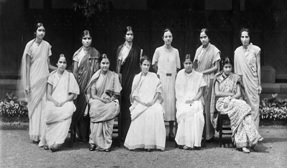
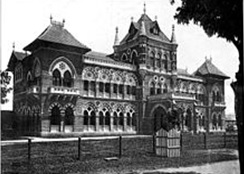
However, once again tragedy struck her. Manorama died suddenly at a tender young age in 1921. She could not recover from that shock. Her health started failing. Within a year she passed away on 5th April 1922 just before her 64th birthday.
Her life was immortalised by India Posts by issuing a stamp in her memory in 1989 (Photo 4). There is also a Road named after her Pandita Ramabai Marg in the Chowpatty – Gamdevi area of Mumbai (photo 5)
3) Padmashri Dr. (Miss) Jerusha Jhirad (1891-1984)
The crater in her memory is named JHIRAD crater.
Dr. Miss Jerusha Jhirad was born on 21th March, 1891 in Karnataka (Shimoga District) in the former princely state of Mysore. She came from the Bene Israeli Jewish Community settled mostly in Maharashtra and were Marathi Speaking. Her early education was in Poona. Dr. Jhirad’s sister was treated by Dr. Annette Benson at the Cama Hospital, Bombay. Her sister’s successful treatment made a lasting impression on Jerusha’s young mind. Miss Jhirad while in school developed a keen desire to qualify as a doctor and be in charge of the Cama and Albless Hospital for Women, Bombay.
Jerusha had a brilliant career in school, where she was a merit scholar and later at the Grant Medical College, Bombay from where she graduated in 1912.
Dr. Jhirad was the first woman to get Tata Loan for studies in England and also Government Scholarship. She was admitted to the “London Medical School for Women” for M. D. She returned to India in 1919 with an MD (London).
In 1925, Dr. Jhirad started private practice in Bombay and was soon appointed Honorary Surgeon, Cama Hospital (1925-28). In 1928, Dr. Jhirad was appointed Superintendent of the same hospital. Her long awaited dream of her young days was thus fulfilled. Dr. Jhirad was the first Indian to have this post. Dr. Jhirad developed the undergraduate and post graduate (M.D., D.G.O.) training and the hospital was affiliated to the Grant Medical College as a Post Graduate Teaching Hospital for women students for Obstetrics and Gynaecology.
She was President of the Association of Medical Women during 1947-57. She was the Founder Member of the Federation of Obstetrics and Gynaecological Society of India and President and presided over the sixth All India Congress of Obstetricians and Gynaecologists held in Madras. She was also the Founder Editor of the official Journal of FOGSI.
She was decorated with M.B.E. in 1945 by British Government and with Padmashri in 1962 by Indian Government.
Dr. Jhirad retired from the Cama Hospital in 1947 but continued medical practice in Bombay. On her 80th birthday in 1971, her friends and well wishers from AMWI started a Post-Graduate Library in Cama and Albless Hospital. It still exists and functions from Cytology Clinic.
She kept in touch with the women doctors in Bombay and other places who had much respect and affection for her. I am one such person. To me she was a Teacher, Mentor and a grand-motherly person. When she got ill, she was brought to St. Elizabeth Hospital. I was with her when she passed away on 2nd June 1984.
After she passed away in 1984 again her friends and well-wishers started a Dr. Jerusha Jhirad Memorial Fund. An oration in her memory was instituted. It is given at Medical Women’s International Association at their Triennial International Conference. It has become a very prestigious oration. A tribute is paid to her memory at the start of the oration.
There have been many Space Missions to study Venus. The then USSR sent 30 Venera Missions to Venus starting in 1961. Currently a Japanese Akatsuki spaceship is orbiting Venus. India is planning to send a Mission to Venus as early as 2024.
As Science advances, more craters will be identified and named. Many more Women may get honoured.
In general there is no bar on the achievements of Women Scientists and Doctors currently. Many have reached the pinnacle of their chosen professions. We must all feel proud of their contribution to the Profession and to society.
It is hoped that these life sketches will prove to be “Inspirational” for the future generations.
About the Author
Dr. Usha Saraiya is a Practising Gynaecologist who lives in Malabar Hill area. She has been a Professor at Grant Medical College and is the
Author of 8 Textbooks and over 100
Scientific publications.
